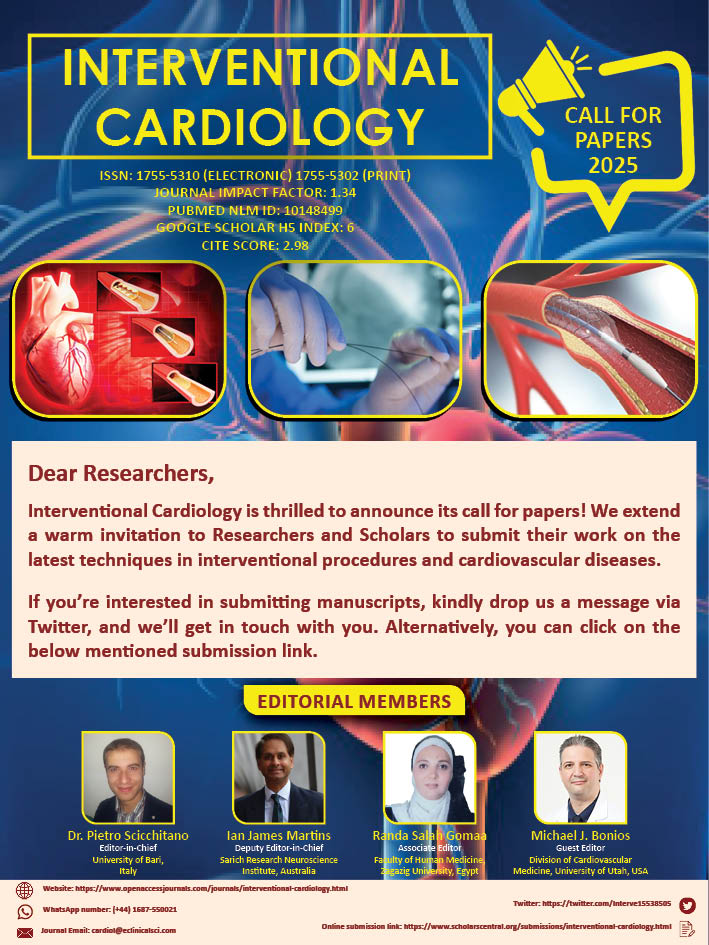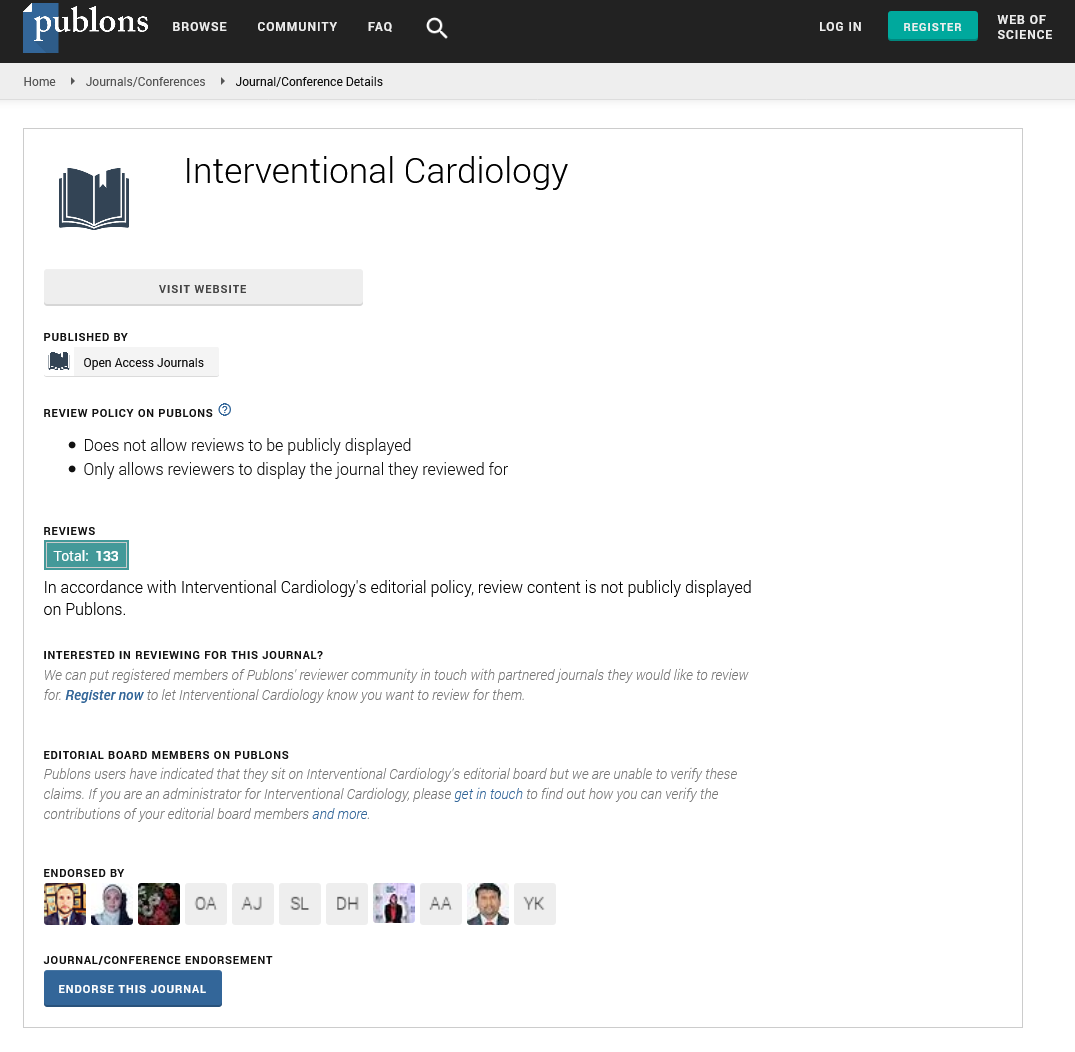Editorial - Interventional Cardiology (2025) Volume 17, Issue 0
Spontaneous Coronary Artery Dissection (SCAD) as a potential cause of Acute Coronary Syndrome (ACS) in young females
- Corresponding Author:
- Randa Salah Gomaa Mahmoud
Department of medical physiology, Faculty of human medicine, Zagazig University, Zagazig, Egypt
E-mail: RSGomaa@medicine.zu.edu.eg
Received date: 03-Feb-2025, Manuscript No. FMIC-25-164416; Editor assigned: 05-Feb-2025, PreQC No. FMIC-25-164416 (PQ); Reviewed date: 19-Feb-2025, QC No. FMIC-25-164416; Revised date: 26-Feb-2025, Manuscript No. FMIC-25-164416 (R); Published date: 05-Mar-2025, DOI: 10.37532/1755-5310.2025.17(S27).689
Description
Spontaneous Coronary Artery Dissection (SCAD) is increasingly recognized as an emerging cause of Acute Coronary Syndrome (ACS) in young women without any identified cardiovascular risk factors [1,2]. Myocardial Infarction with Non- Obstructive Coronary Arteries (MINOCA) expresses the symptoms of ACS with a cardiac troponin elevation without a significant obstruction of the coronary arteries in invasive angiography [3]. MINOCA displays a complex pathophysiology involving both atherosclerotic and non-atherosclerotic mechanisms. Atherosclerotic mechanisms are related to plaque disruption, while non-atherosclerotic mechanisms primarily include epicardial coronary vasospasm, coronary microvascular dysfunction, coronary embolism/thrombosis, SCAD, and supply/demand mismatch [4].
SCAD is a separation of the coronary artery wall layers, which appears independently of iatrogenic or traumatic injuries. It is a pathophysiological example of MINOCA as it starts vessel luminal obstruction, even if it may not be clear, especially at distal epicardial vessels [5]. Two main mechanisms describe the pathophysiology of SCAD: (i) a mechanism involves the external arterial wall layers with a possible vasa vasorum rupture and arterial wall bleeding; (ii) a mechanism starting from the inner wall layers with intima lacrimation and resultant false lumen formation with media hemorrhage and true lumen compression [6].
Female gender is the most predominant and strongest predisposing factor, accounting for up to 90% of SCAD cases. The major risk factors for SCADP are pregnancy, multiparity, peri- and post-partum status, and hormonal therapy, showing a key role for sex-related hormones [5]. Arteriopathies like Fibromuscular Dysplasia (FMD), which is a non-atherosclerotic and non-inflammatory vascular disease, and is common in younger women, can present with an aneurysm, stenosis, and dissection, and affect the coronary circulation. It was reported that 10.5% of patients with FMD had an arterial dissection, and 2.5% had SCAD [7]. Moreover, Pregnancy-Related SCAD (P-SCAD) appears more severe, involving main and proximal arteries, affecting the left ventricular function that requires invasive treatment [8].
An incidence rate of SCAD ranging from 23% to 36% of myocardial infarction in female patients aged under 50 years is reported by several studies [9-13]. Vanzetto et al. showed that the prevalence of SCAD is 8.7% in women aged < 50 presenting with ACS and 10.8% in cases with ST-Segment Elevation Myocardial Infarction (STEMI) [14]. However, Saw et al reported that SCAD prevalence is increasing in older women [15]. Despite a good overall survival rate, this condition seems theoretically malignant because of recurrences and the possibility that it might cause several complications, such as sudden cardiac death and cardiogenic shock [16].
Coronary angiography is the gold standard for SCAD diagnosis [13]. However, it is not always sufficient for diagnosis, and adjunctive evaluation through Optical Coherence Tomography (OCT) is needed [5]. SCAD involves a single coronary artery and a single artery’s segment, although multidistrict involvement has been reported [2]. According to Yip-Saw angiographic classification, four main types of SCAD have been identified [17,18]; type 1, reported in less than 1/3 of SCAD cases; type 2 is the most frequent SCAD, but also the most angiographically missed; type 3 is misdiagnosed as focal or tubular atherosclerotic lesions. The difference between types 2 and 3 depends on the appearance of intramural hematoma [19]. Type 4 SCAD has recently been described, and it is characterized by total vessel occlusion.
The role of intravascular imaging is increasing, such as Intravascular Ultrasound (IVUS) and OCT, which may stand for useful tools to make diagnoses, principally in suspicious cases. They can additionally be used to guide Percutaneous Coronary Intervention (PCI). The OCT and IVUS use may be associated with dissection extension, iatrogenic new dissections, or vessel occlusion [20-21]. Conservative management with medical therapy is the basis of treatment for SCAD in the absence of high-risk features, as invasive treatment with PCI may be associated with an iatrogenic dissection or with a further extension of SCAD and affect the ischemia severity. Moreover, PCI does not protect against recurrent SCAD [22]. The anatomic and pathophysiological challenges of SCAD injuries cause high failure rates of PCI [23]. High-risk patients may benefit from an invasive approach with a reliable mediumterm outcome, despite a higher complication rate [24]. Coronary Artery Bypass Graft (CABG) has favorable early clinical outcomes, despite a significant graft occlusion rate at 5 years [3].
The treatment targets of SCAD are to relieve symptoms and prevent recurrence. There is a lack of evidence concerning the ideal medical treatment of SCAD due to the lack of randomized data [2]. Currently, long-term medical therapy includes acetylsalicylic acid and beta-blockers [25]. Beta-blockers are associated with diminished recurrence of SCAD because of their shear stress reduction power [26]. However, beta-blockers must be used with caution, especially if SCAD affects the right coronary, to avoid bradycardia and hypotension [25]. The Dual Antiplatelet Therapy (DAPT) usage is a main concern in patients who did not undergo revascularization. DAPT strategy is encouraged for the first month because recurrence is higher [17]. Now, there is no standardized protocol regarding the need for DAPT and its duration [5].
In summary, SCAD is a rare cause of ACS whose pathophysiology, diagnosis, and treatment have been increasingly studied only in recent years. However, SCAD remains a challenging condition, with a prevalence in women that is incompletely understood. Future studies should be directed to understand the associated conditions that predispose patients to arteriopathy and intramural hematoma formation, harness multimodality imaging to optimize the diagnosis and follow-up of SCAD, clarify the role of medical therapy, and identify strategies to improve the success rate of PCI.
References
- Saw J, Mancini GJ, Humphries KH, et al. Contemporary review on spontaneous coronary artery dissection. J Am Coll Cardiol. 68(3):297-312 (2016).
- Yang C, Alfadhel M, Saw J, et al. Spontaneous coronary artery dissection: Latest developments and new frontiers. Curr Atheroscler Rep. 22(9):49 (2020).
- Byrne RA, Rossello X, Coughlan J, et al. 2023 ESC Guidelines for the management of acute coronary syndromes. Eur Heart J. 13(1):55-161 (2024).
- Severino P, D’Amato A, Prosperi S, et al. Myocardial Infarction with Non-Obstructive Coronary Arteries (MINOCA): Focus on coronary microvascular dysfunction and genetic susceptibility. J Clin Med. 12(10):3586 (2023).
- D’Amato A, Mariani MV, Prosperi S, et al. Spontaneous coronary artery dissection in clinical practice: Pathophysiology and therapeutic approaches. Medicina. 60(2):217 (2024).
- Djokovic A, Krljanac G, Matic P, et al. Pathophysiology of spontaneous coronary artery dissection: Hematoma, not thrombus. Front Cardiovasc Med.10:1260478 (2023).
- Kadian-Dodov D, Gornik HL, Gu X, et al. Dissection and aneurysm in patients with fibromuscular dysplasia: findings from the US Registry for FMD. J Am Coll Cardiol. 68(2):176-185 (2016).
- Zeven K. Pregnancy-associated spontaneous coronary artery dissection in women: A literature review. Curr Ther Res Clin Exp. 98:100697 (2023).
- Saw J, Aymong E, Mancini GJ, et al. Nonatherosclerotic coronary artery disease in young women. Can J Cardiol. 30(7):814-819 (2014).
- Rashid HN, Wong DT, Wijesekera H, et al. Incidence and characterisation of spontaneous coronary artery dissection as a cause of acute coronary syndrome a single-centre Australian experience. Int J Cardiol. 202:336-338 (2016).
- Nakashima T, Noguchi T, Haruta S, et al. Prognostic impact of spontaneous coronary artery dissection in young female patients with acute myocardial infarction: A report from the Angina Pectoris–Myocardial Infarction Multicenter Investigators in Japan. Int J Cardiol. 207:341-348 (2016).
- Motreff P, Malcles G, Combaret N, et al. How and when to suspect spontaneous coronary artery dissection: Novel insights from a single-centre series on prevalence and angiographic appearance. EuroIntervention. 12(18):e2236-e2243 (2017).
- Adlam D, Alfonso F, Maas A, et al. European Society of Cardiology, acute cardiovascular care association, SCAD study group: A position paper on spontaneous coronary artery dissection. Eur Heart J. 39(36):3353-3368 (2018).
- Vanzetto G, Berger-Coz E, Barone-Rochette G, et al. Prevalence, therapeutic management and medium-term prognosis of spontaneous coronary artery dissection: Results from a database of 11,605 patients. Eur J Cardiothorac Surg. 35(2):250-254 (2009).
- Saw J, Aymong E, Sedlak T, et al. Spontaneous coronary artery dissection: Association with predisposing arteriopathies and precipitating stressors and cardiovascular outcomes. Circ Cardiovasc Interv. 7(5):645-655 (2014).
- Solinas E, Alabrese R, Cattabiani MA, et al. Spontaneous coronary artery dissection: An Italian single centre experience. J Cardiovasc Med (Hagerstown).23(2):141-148 (2022).
- Adlam D, Tweet MS, Gulati R, et al. Spontaneous coronary artery dissection: Pitfalls of angiographic diagnosis and an approach to ambiguous cases. JACC Cardiovasc Interv. 14(16):1743-1756 (2021).
- Lebrun S, Bond RM. Spontaneous Coronary Artery Dissection (SCAD): The underdiagnosed cardiac condition that plagues women. Trends Cardiovasc Med. 28(5):340-345 (2018).
- Kronzer VL, Tarabochia AD, Lobo Romero AS, et al. Lack of association of spontaneous coronary artery dissection with autoimmune disease. J Am Coll Cardiol. 76(19):2226-2234 (2020).
- Marrazzo G, Palermi S, Pastore F, et al. Multimodality imaging approach to spontaneous coronary artery dissection. J Clin Med. 12(1):154 (2022).
- Mehmedbegovic Z, Ivanov I, Cankovic M, et al. Invasive imaging modalities in a spontaneous coronary artery dissection: When “believing is seeing”. Front Cardiovasc Med. 10:1270259 (2023).
- Bocchino PP, Angelini F, Franchin L, et al. Invasive versus conservative management in spontaneous coronary artery dissection: A meta-analysis and meta-regression study. Hellenic J Cardiol. 62(4):297-303 (2021).
- Shah T, Zhong M, Feldman DN, et al. Spontaneous coronary artery dissection: Diagnostic challenges and updates in management. Curr Treat Options Cardiovasc Med. 27(1):30 (2025).
- Kotecha D, Garcia-Guimaraes M, Premawardhana D, et al. Risks and benefits of percutaneous coronary intervention in spontaneous coronary artery dissection. Heart. 107(17):1398-1406 (2021).
- Ilic I, Radunovic A, Timcic S, et al. Drugs for spontaneous coronary dissection: A few untrusted options. Front Cardiovasc Med. 10:1275725 (2023).
- Saw J, Humphries K, Aymong E, et al. Spontaneous coronary artery dissection: Clinical outcomes and risk of recurrence. J Am Coll Cardiol. 70(9):1148-1158 (2017).

